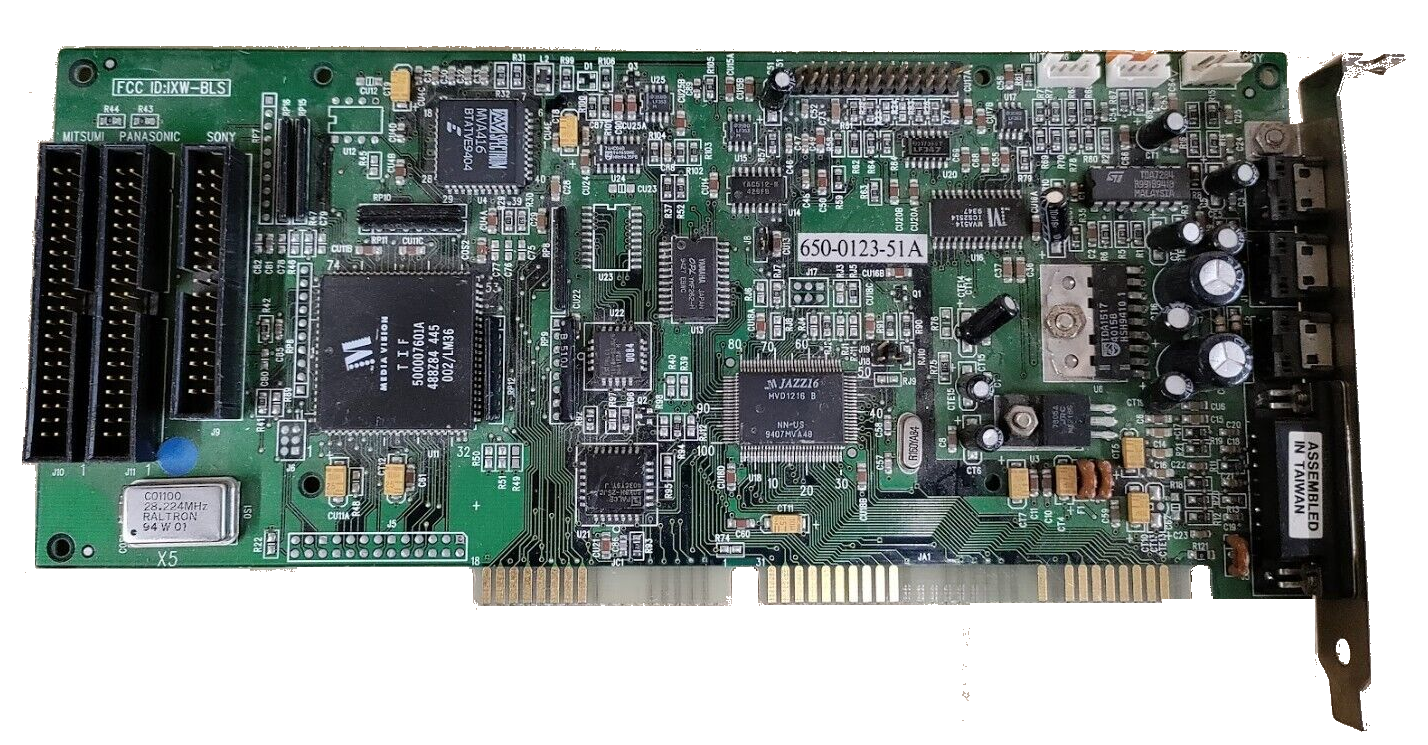.jpg) Jazz16 Jazz16    
Introduced: 1993
FM Synth: Yamaha YMF262-M (OPL3)
Chipset: Jazz16 (MVD1216)
Mixer Chip: MVA-416
Wavetable Header: Some models
CD-ROM interface: IDE or Panasonic (IXW-JAZZ16), Sony/Panasonic/Mitsumi (KRN3261).
Model #: 650-0066-06D
FCC ID: IXW-JAZZ16, KRN3261
Media Vision's new chipset for 1993, Jazz16, was an Ad Lib, Sound Blaster, and Sound Blaster Pro compatible. It was
*NOT* compatible with the earlier Pro Audio Spectrum line.
This board has hardware volume control via a dial on the backplate, like the early Sound Blasters.
Media Vision licenced their Jazz16 chipset to a number of OEMs, including Gateway 2000 and KTL (FCC IDs starting with KRN, e.g. KRN3261). It was also sold to Quickshot for their QS805, to Identity Systems Technology with their IDCDKIT1 who branded their version of the card 'CHIC', and to Octek who called theirs the 'Octek MV-16'.
The Jazz chipset has a bug where the MIDI buffer is too small, so it would drop data once in a while resulting in a missed note or sometimes a stuck note. This made using either the MIDI port or the wavetable header next to useless.
A "3D Pro" version of the Jazz16 came bundled with a Korg wavetable daughterboard.
DOS driver incl. CD-ROM support
More Images
.jpg) 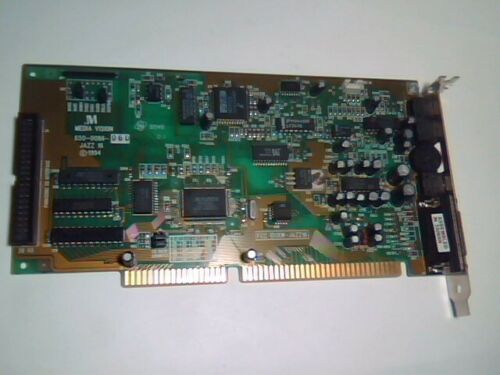 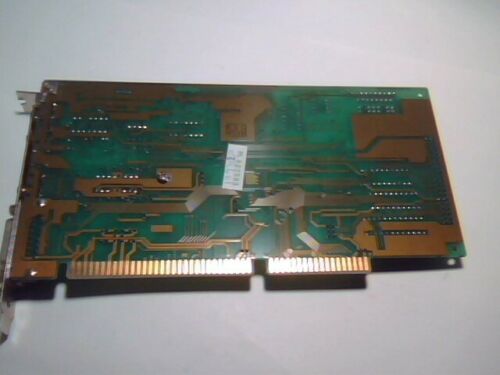 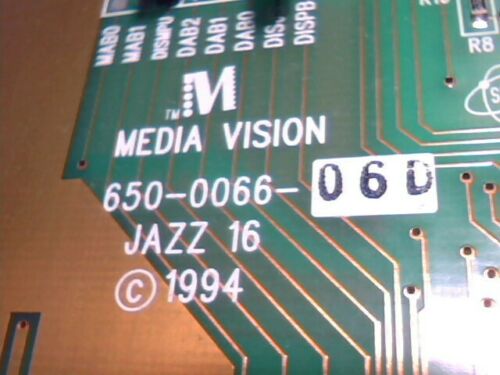 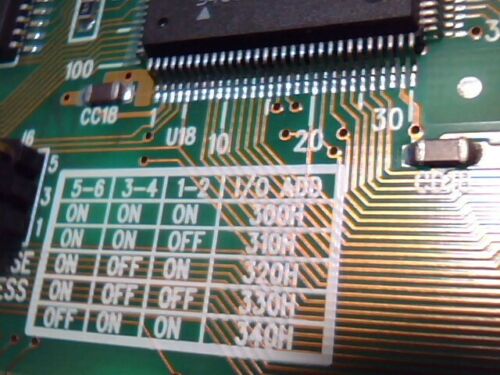 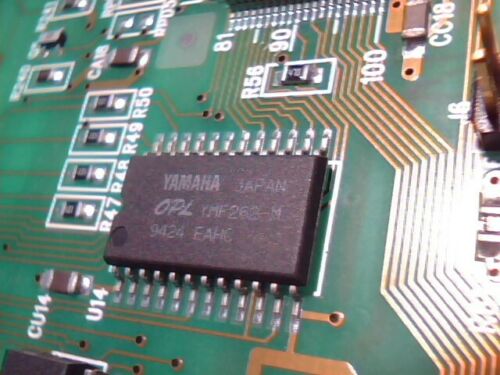 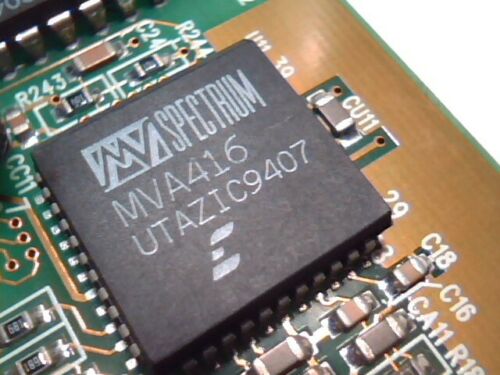 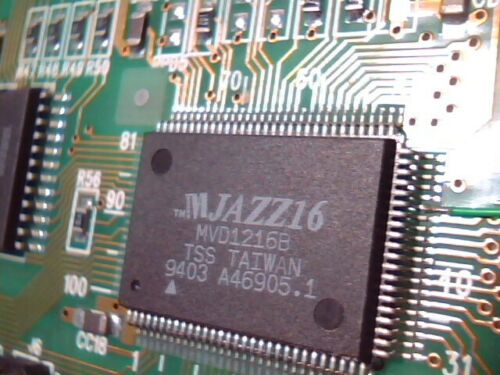 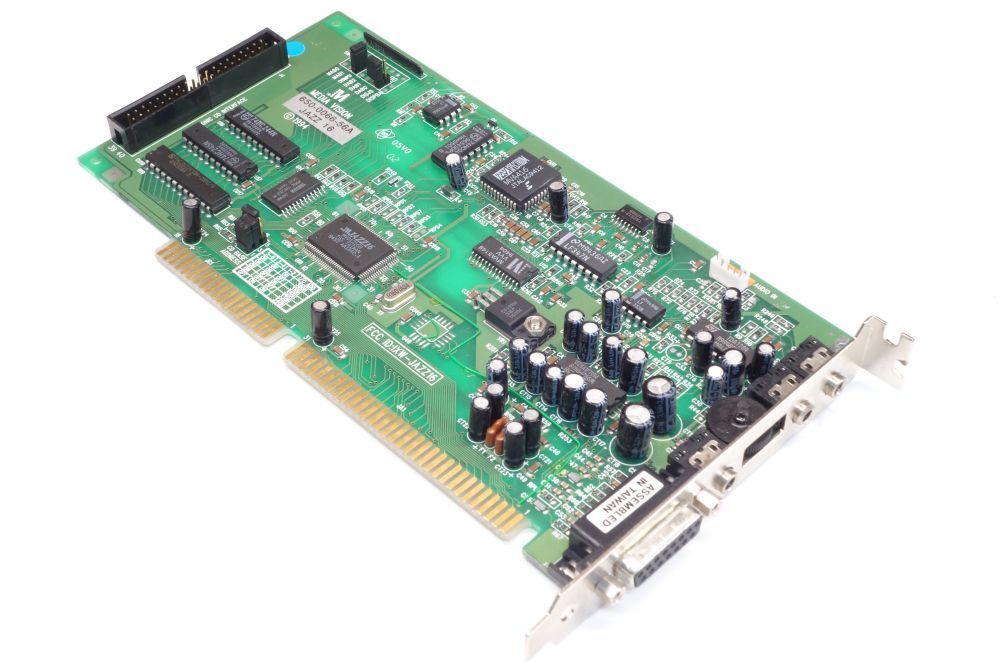 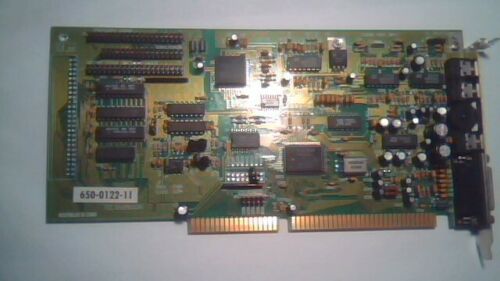  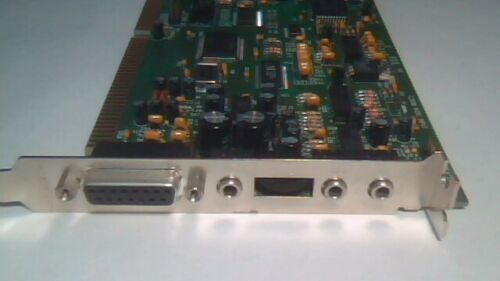
Image at the top and first one above courtesy of DOS Days' contributor, targeted.
|
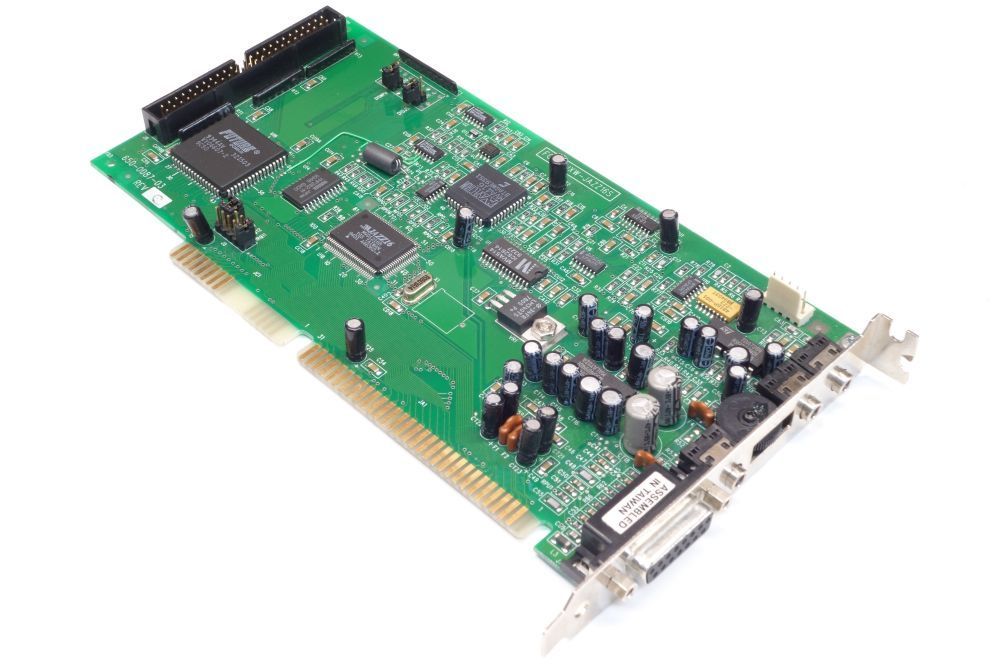 Pro Sonic 16 SCSI Pro Sonic 16 SCSI    
Introduced: 1993
FM synthesizer: Yamaha YMF262-M (OPL3)
Chipset: Jazz16 (MVD1216)
Mixer Chip: MVA-416
Wavetable header: None
Model #: 650-0066-02, 650-0087-03, 650-0087-53, 650-0087-54
FCC ID: IXW-JAZZ16S
Known Revisions: A , C
Combines the Thunder Board chipset with the Jazz16 chipset (which is sort-of Sound Blaster 16 compatible). Not compatible with Pro Audio Spectrum line.
SCSI interface for CD-ROM.
This board has hardware volume control via a dial on the backplate, like the early Sound Blasters.
The Jazz chipset has a bug where the MIDI buffer is too small, so it would drop data once in a while resulting in a missed note or sometimes a stuck note.
According to the Microsoft Sidewinder 3D Pro documentation, the Pro Sonic is one of several boards that do not provide full game port functionality, i.e. the Sidewinder (as perhaps other peripherals) will not function on them.
More Images
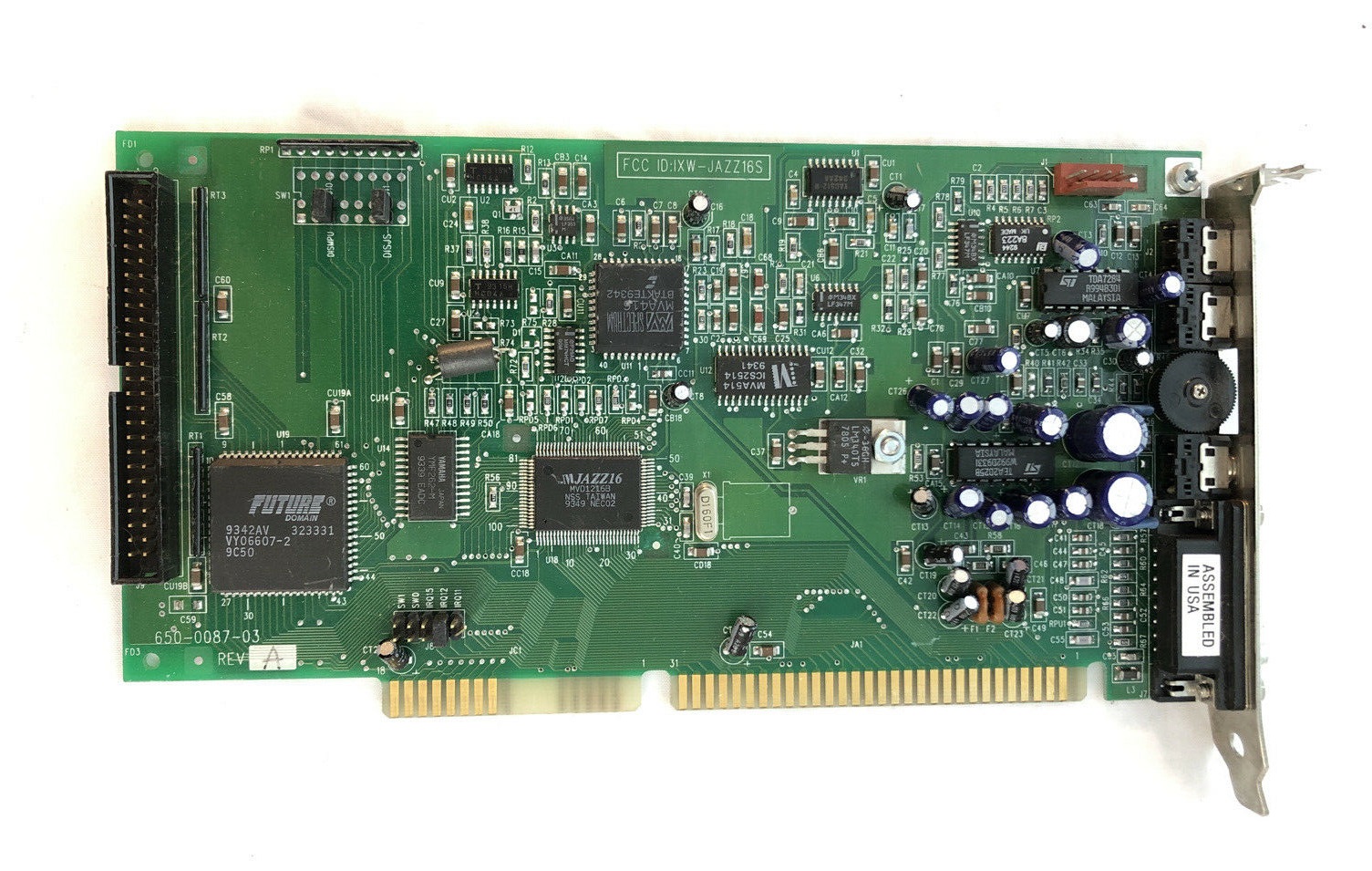 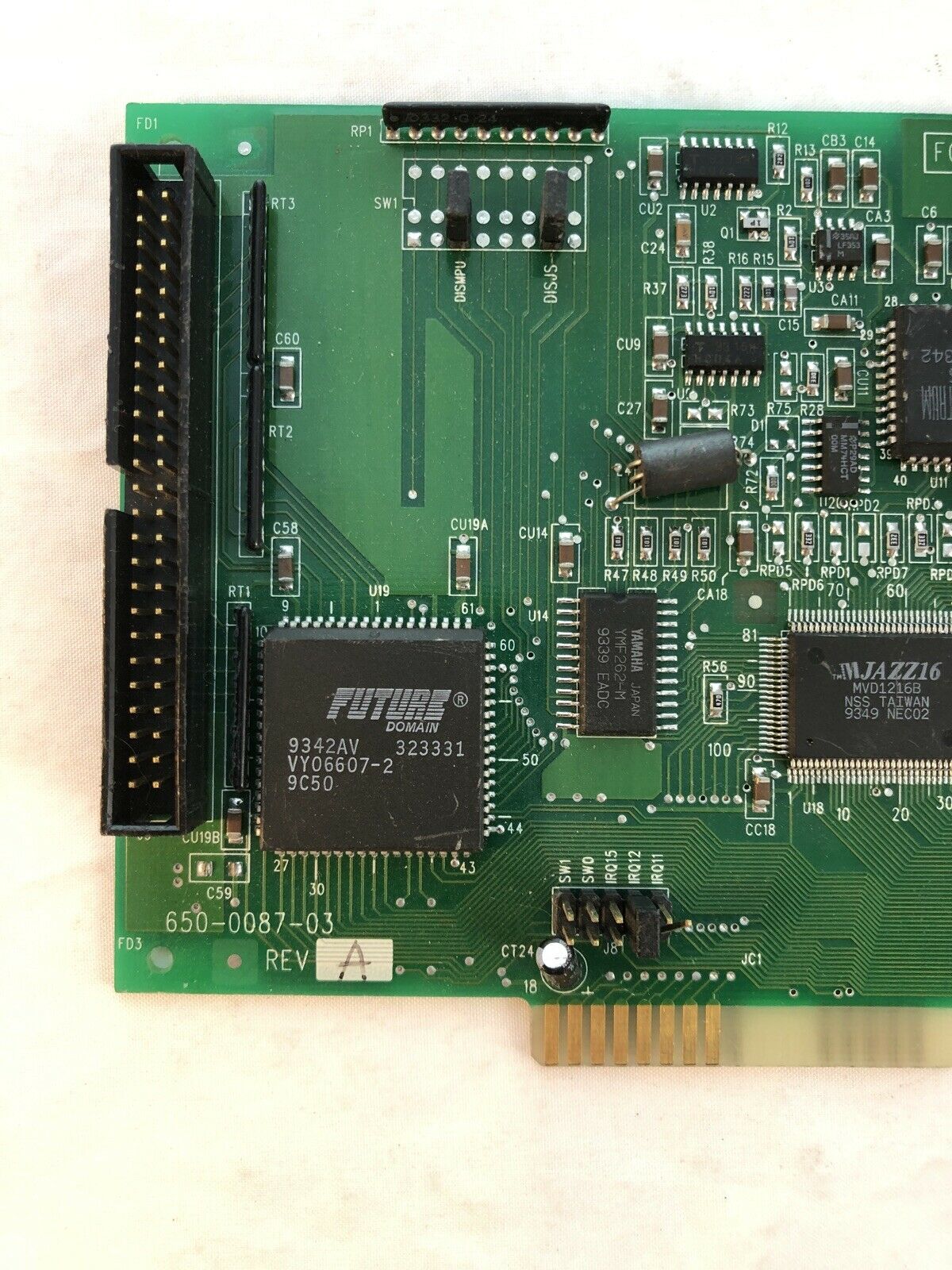 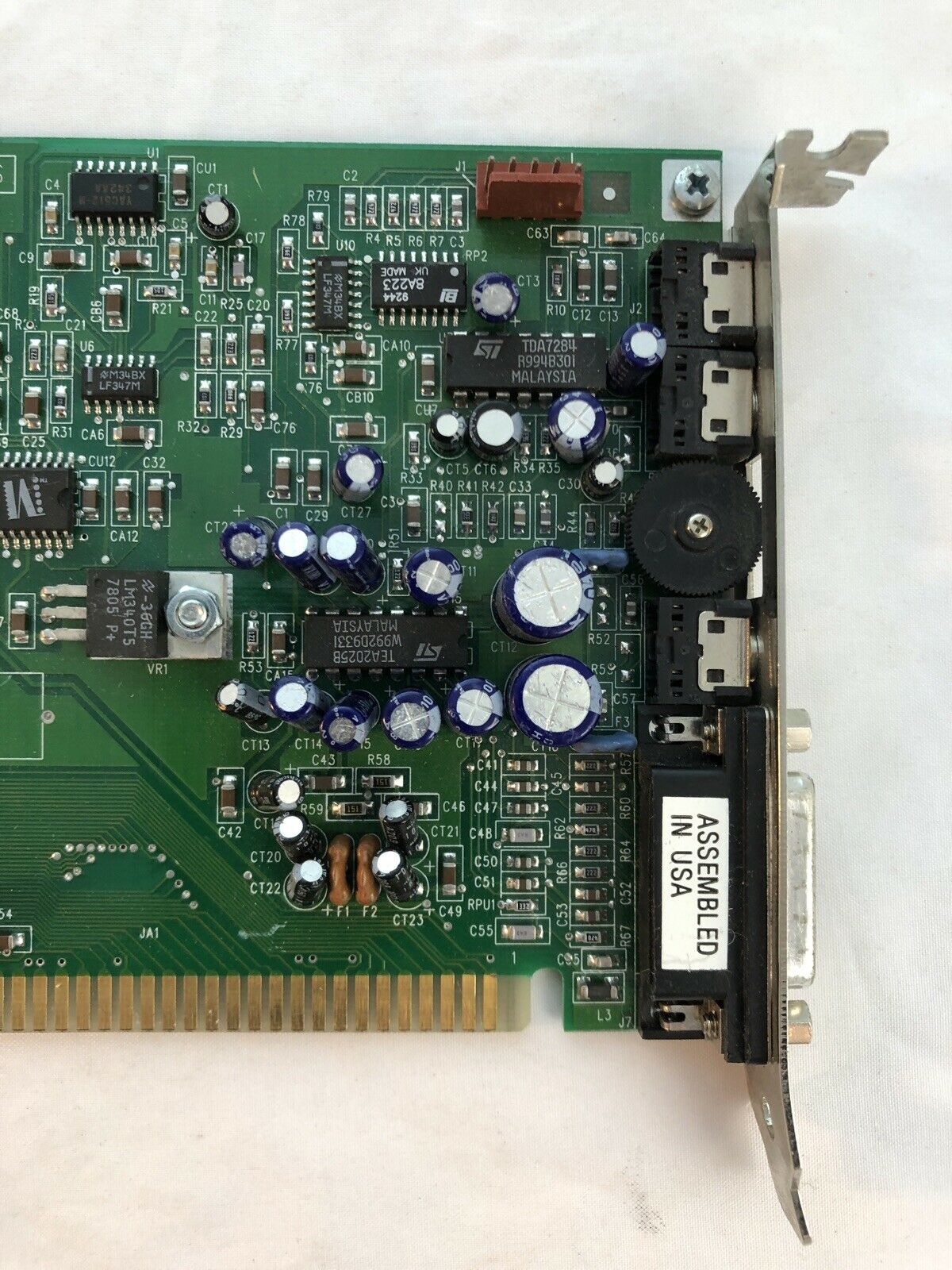 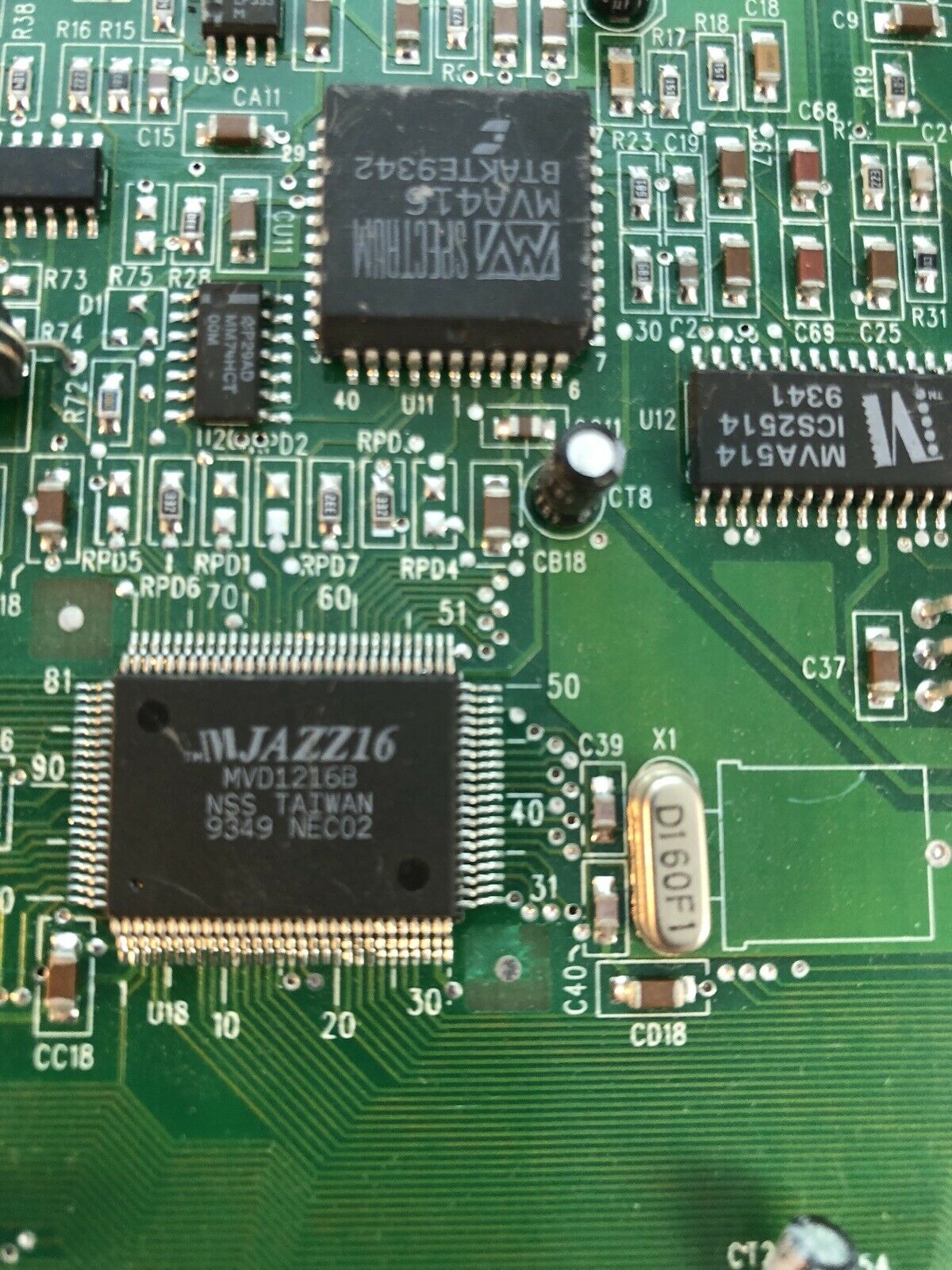 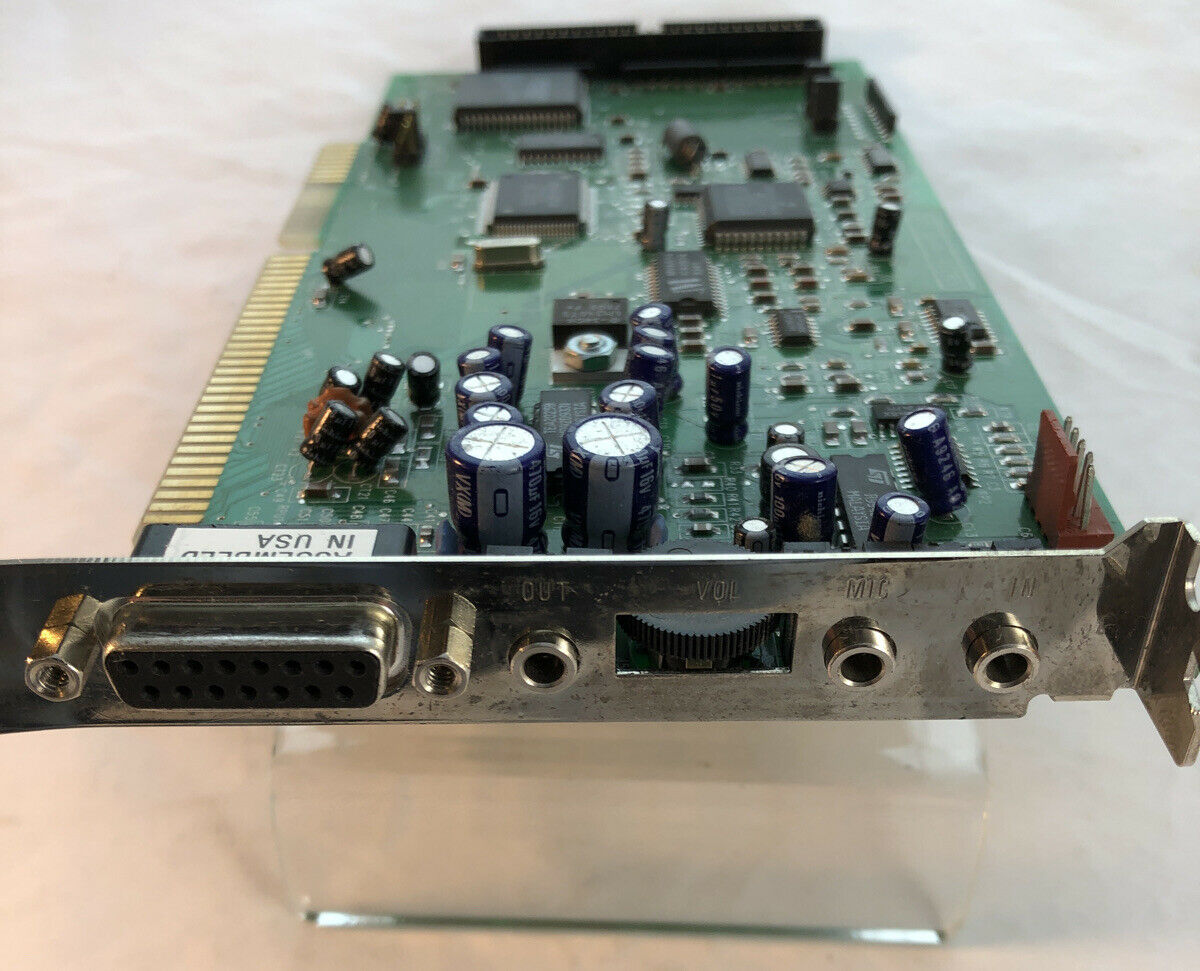
|
 Pro 3D / Premium 3D Pro 3D / Premium 3D     
Introduced: 1994
Chipset: Jazz16 (MVD1216)
Wavetable header.
Ad Lib, Sound Blaster, and Sound Blaster Pro compatible.
*NOT* compatible with Pro Audio Spectrum line.
Faster SCSI CD-ROM interface.
Mixer Chip: MVA-508B
Part #: 650-0111--1 (Premium 3D SCSI), 650-0098-05 (Premium 3D Multi CD)
FCC ID: IXW-JAZZ16S
Price: $199 (1994), $145 (Jun 1994 - Premium 3D SCSI-2), $265 (Jun 1994 - Pro 3D), £259 (Mar 1995 - Pro 3D SCSI-2)
The Pro 3D and Premium 3D cards built upon the Pro Audio Spectrum 16 line by offering SRS surround sound technology, a "supported" Wave Blaster header, Sound Blaster 2.0 digital and FM compatibility, and support for VESA's VBE/AI sound standard initiative. The optional Media Vision Korg Pro Wave wavetable daughterboard upgrade sold for $199.
The MVA-508B mixer chip was not Sound Blaster Pro mixer-level compatible - this would be rectified in a later card, the Deluxe.
The Premium 3D card was also bundled in Media Vision's Premium Deluxe Multimedia Kit in late 1994. It sold for $599 along with the Media Vision Reno external double-speed SCSI CD-ROM drive and software titles including Compton's Interactive Encyclopedia, Home Survival Toolkit, Iron Helix, Kid's Zoo, Mayo Clinic Family Health Book, and Return to Zork. In March 1995, this multimedia kit sold for £489.
In DOS, the Pro 3D and Premium 3D do not support 16-bit digital playback outside of the VESA driver interfacing.
There was also a Premium 3D Multi-CD version of this card which replaced the SCSI header with Sony, Panasonic and Mitsumi CD-ROM headers.
Also sold as the Pro [Audio] 3D, which consisted of the Premium 3D card bundled with a Korg "Pro Wave" wavetable daughterboard (part #650-0120-01). This wavetable board came with a 4 MB sample ROM and had reverb and chorus effects processing. The card came with a slightly cut-down version of MidiSoft's Sound Impression Windows software (the same one bundled with the Roland RAP-10 sound card), which allows you to record and edit your own tracks and store them in a WAV file. Also bundled with the Pro 3D was MidiSoft's Recording Session for sequencing, Monologue, a text-to-speech application, and Dragon's Talk-To Plus which allows you to control Windows using your voice.
"'3-D sound' coming from Media Vision
Media Vision Inc. last week announced a family of sound boards as well as its plans to drop prices on products already in the channel.
To create a fuller sound the three boards slightly delay the sounds coming from the right speaker. Media Vision has dubbed the effect '3-D sound.'
The Media Vision Premium 3-D SCSI-2 card lists for $199 and includes a 2.5MB-per-second (Mbps) SCSI-2 adapter that handles burst rates as high as 5 Mbps.
Also listing for $199 is the Media Vision Premium 3-D Multi CD sound card, which comes with interfaces for Sony, Panasonic, and Mitsumi CD-ROM drives. Both cards can be upgraded with a $199 wave-table synthesis module that
will ship in the second quarter.
For users who want wave-table synthesis already installed on the board, Media Vision will ship the Media Vision Pro 3-D for $379.
Other companies create more sophisticated but similar 3-D sound effects with delays and pitch changes that fool the ear into thinking the sound is emanating from many locations, said Satish Gupta, vice president of strategic marketing. However, those boards require software companies to write the effects into their software, he said. Media Vision's boards do not require specially written software to create the sound effect.
The boards will ship in April as stand-alone cards and in some of the company's multimedia upgrade kits.
The three cards feature 16-bit stereo and 20-voice FM synthesis. They come with several programs, including a MIDI sequencer and Dragon Systems voice-recognition software.
Media Vision licenses the same 3-D sound technology from SRS Labs, Inc. that is used in RCA and Sony televisions.
The company also announced last week that it will drop prices on already shipping products. In addition, a forthcoming multimedia product will be delayed into the second quarter.
The price cuts, along with the product delay, will result in a first quarter loss, Media Vision officials said, adding that the cuts were in response to competition from other vendors.
"
Info World, 4th April 1994
According to the Microsoft Sidewinder 3D Pro documentation, the Premium 3D is one of several boards that do not provide full game port functionality, i.e. the Sidewinder (as perhaps other peripherals) will not function on them.
Rich Heimlich said this of the Pro 3D card: "One of the best single card solutions available. Includes nice
creature comforts like built-in SRS and a basic effects processor.
It's also SB-Pro compatible. My biggest problems are the lack of a
supportable 16-bit mode and the need to use a 6k TSR. Should prove
to be a nice Windows 95 card. The Premium 3-D is the same card
without the Korg AI2-based daughterboard.". His scores were 7.5 for digital quality and 7.0 for music quality (out of 10).
More Images
 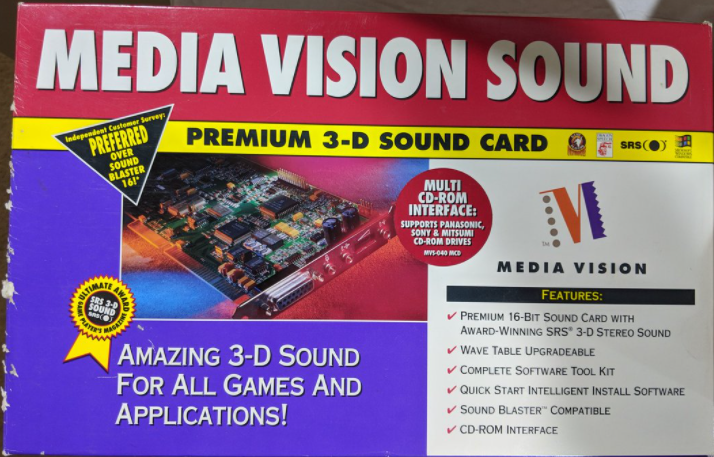
|
 Deluxe Deluxe    
Chipset: Jazz16 (MVD1216)
Wavetable header
Ad Lib, Sound Blaster, and Sound Blaster Pro compatible
*NOT* compatible with Pro Audio Spectrum line.
Faster SCSI CD-ROM interface.
Mixer Chip: MVA-514
Part #: 650-0123-01
In the Deluxe which was a follow-up to the Premium 3D card, the mixer chip, MVA-514, was less feature-rich than the earlier MVA-508B of the Pro 3D/Premium 3D, but it did add Sound Blaster Pro mixer-level compatibility. It dropped the SRS surround sound technology.
The Wavetable header could also be used with the Korg Pro Wave (MV part #650-0120-01), just like the Pro 3D and Premium 3D cards (see above). This used the 4 MB Korg AI2 soundfonts. A Deluxe plus the Korg DB would cost $226 when new.
|
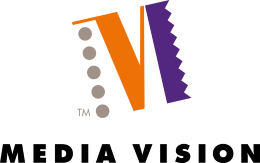 Media Vision
Media Vision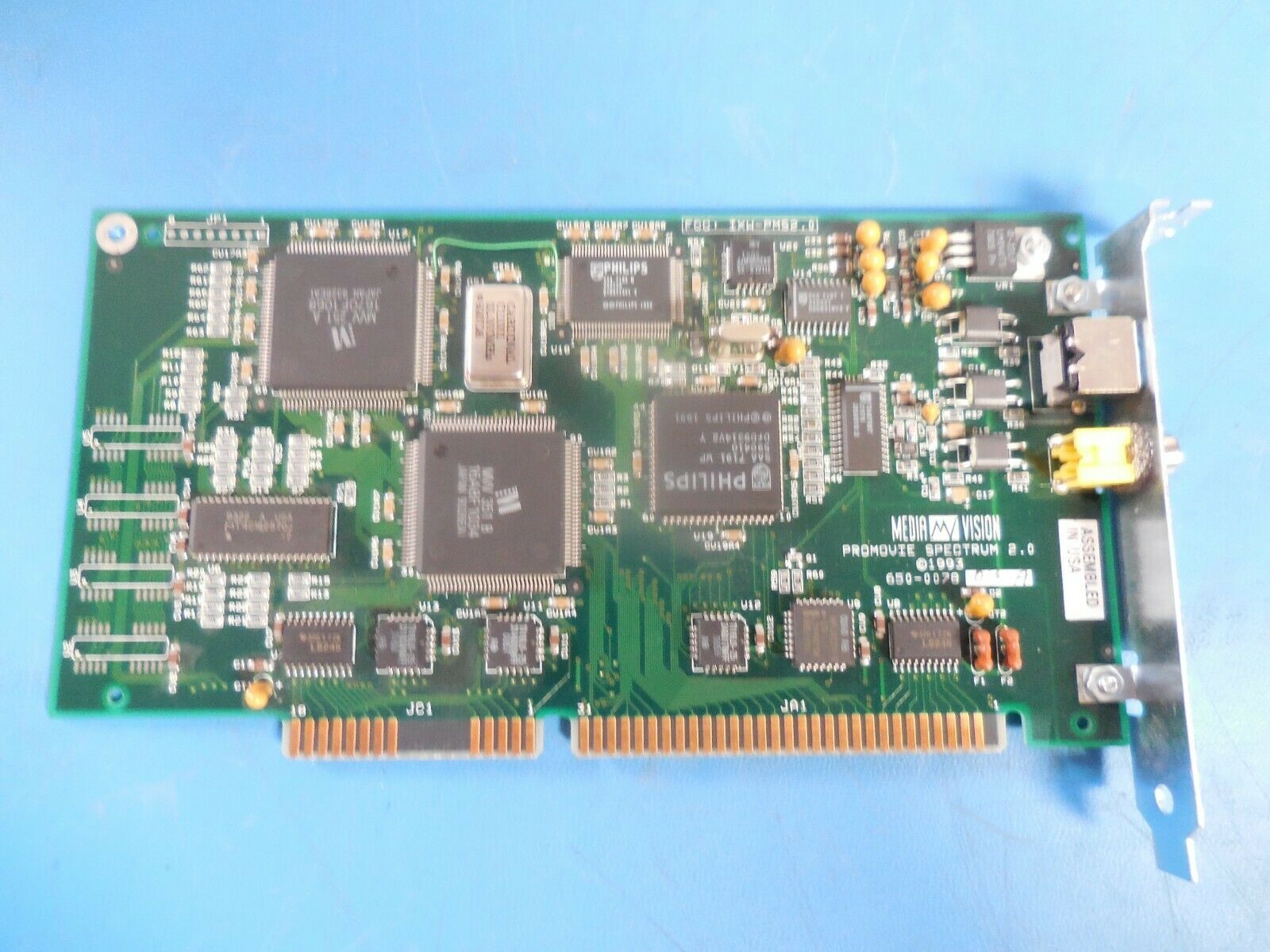
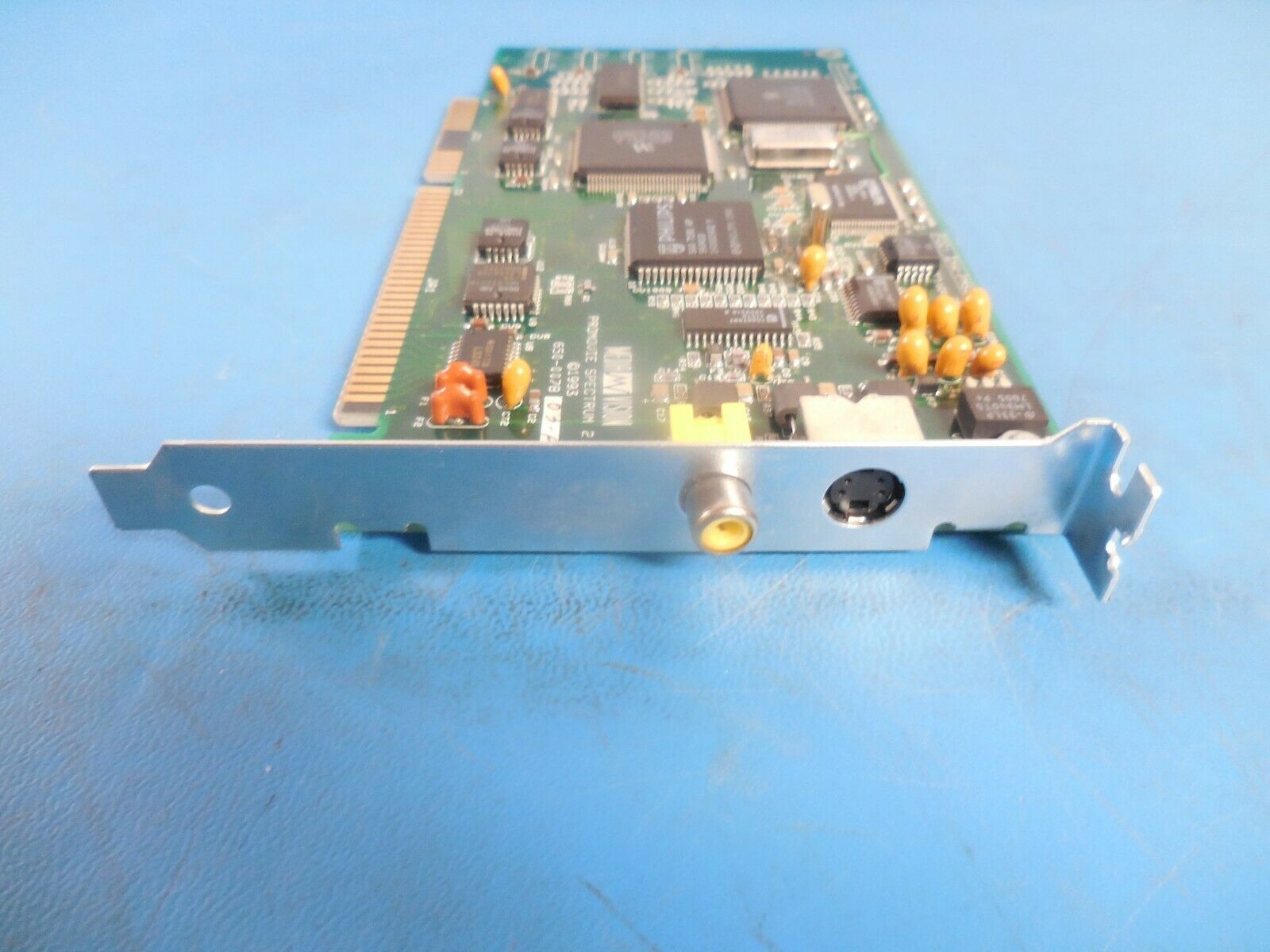
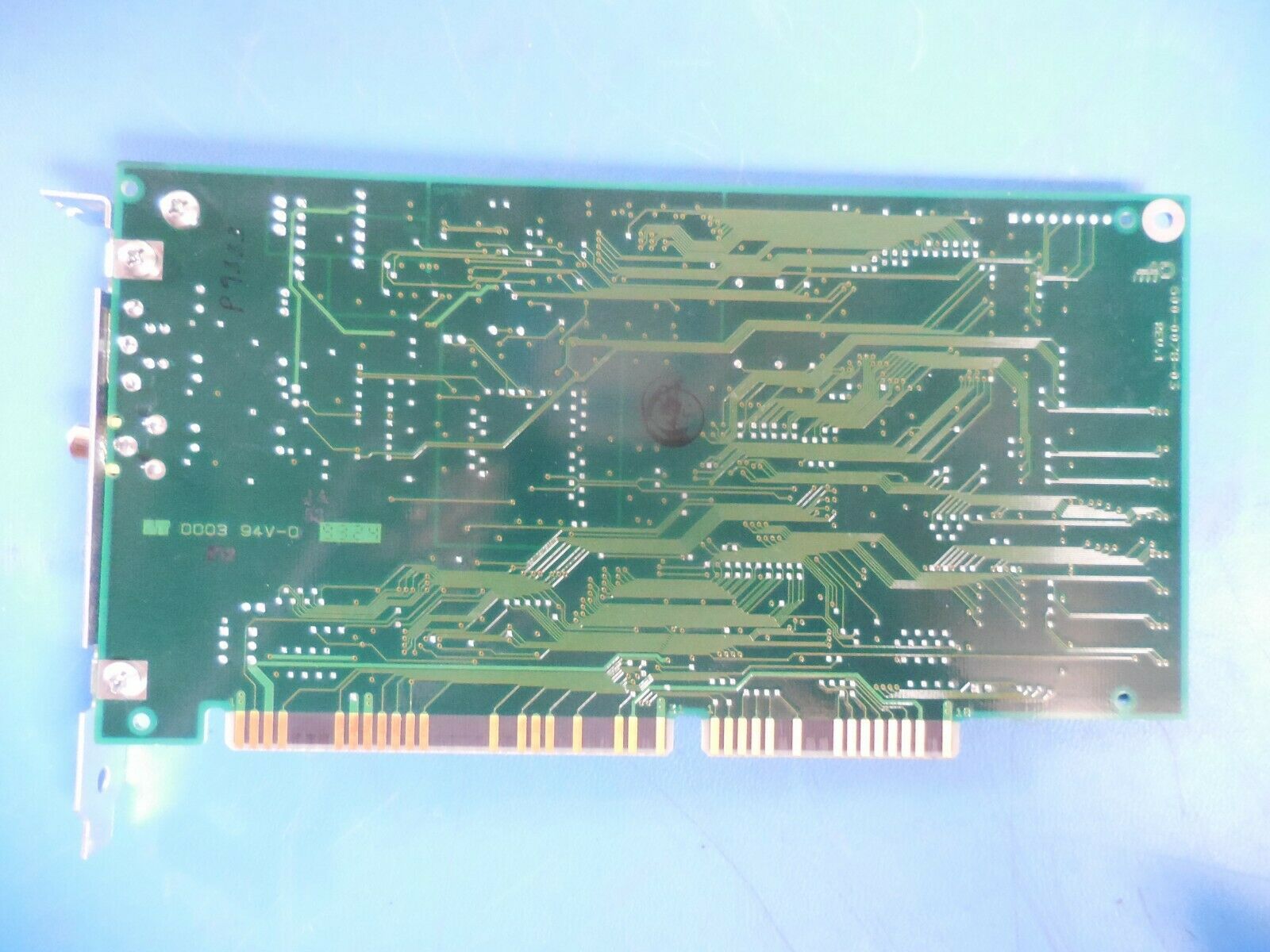
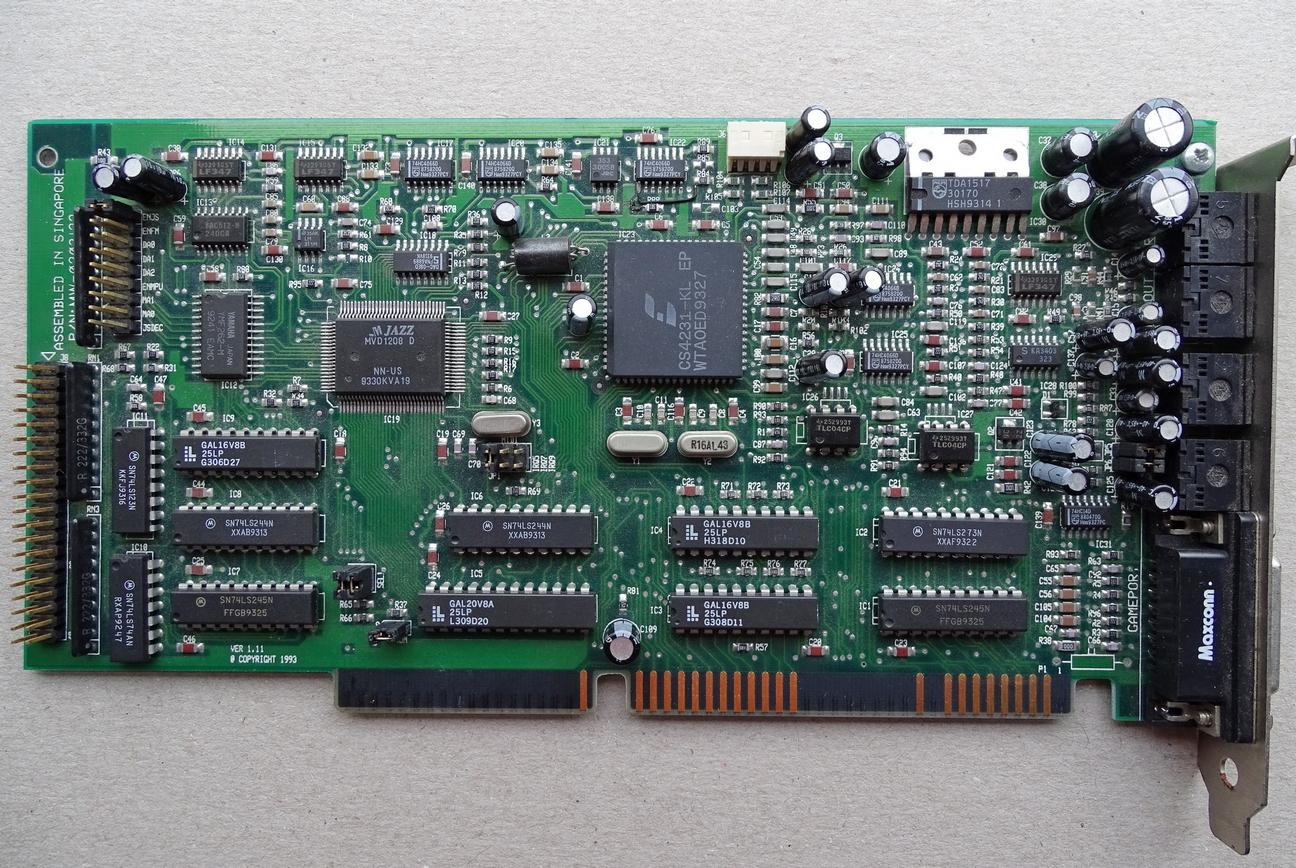
.jpg)
.jpg)




















